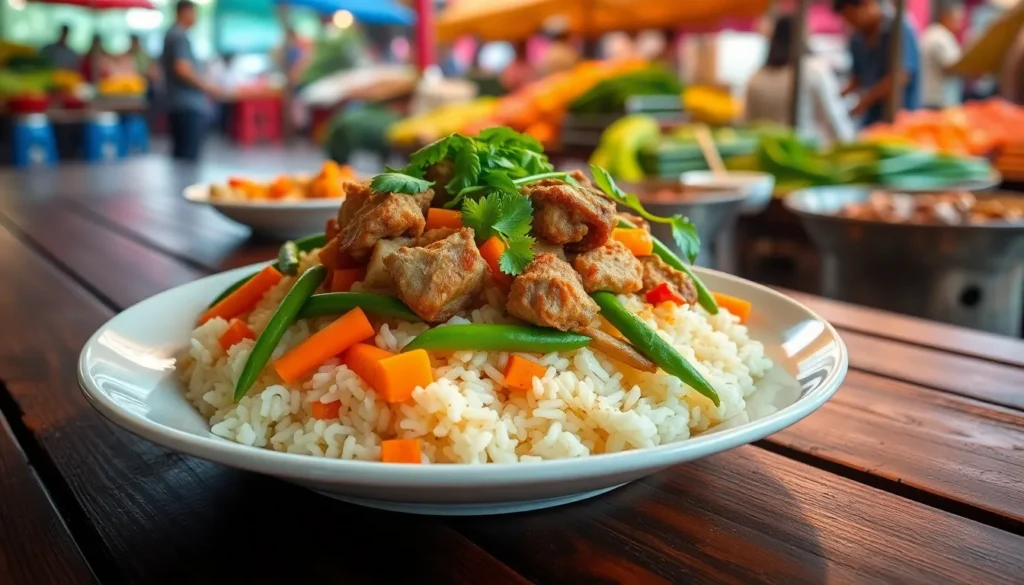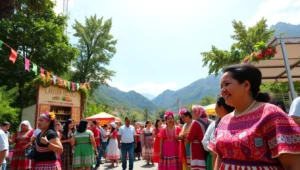In the vibrant tapestry of Myanmar’s cuisine, hingagyi stands out like a dazzling gem. This beloved dish isn’t just food; it’s a cultural experience that tickles the taste buds and warms the soul. Imagine sinking your teeth into a savory delight that combines rich flavors and textures, all while feeling like you’re part of a grand culinary adventure.
Table of Contents
ToggleOverview of Hingagyi
Hingagyi represents a significant element of Myanmar’s culinary landscape. This dish combines various ingredients, creating layers of flavor and texture that appeal widely to both locals and visitors. Characterized by its savory taste, hingagyi often features a base of rice mixed with aromatic spices, vegetables, or meats.
The preparation of hingagyi reflects traditional cooking methods, showcasing regional ingredients and culinary techniques. In many households, it serves as a staple meal during celebrations and gatherings, making it a communal experience. Different variations exist across regions, each bringing unique twists to the dish’s essence.
People appreciate hingagyi not only for its taste but also for the memories it evokes. Family members often gather to enjoy this dish together, emphasizing its role in fostering connections. When prepared, the enticing aroma fills the air, drawing people in and hinting at the delightful experience ahead.
Restaurants in Myanmar frequently offer hingagyi on their menus, appealing to a diverse audience. Diners can expect a warm and comforting dish that satiates hunger while providing a glimpse into Myanmar’s rich culinary heritage. This dish embodies the heart of Myanmar’s food culture, celebrating the blend of flavors and communal spirit inherent in local dining traditions.
History of Hingagyi

Hingagyi holds a significant place in Myanmar’s culinary history. This dish symbolizes cultural traditions and communal values that define the nation.
Cultural Significance
Hingagyi acts as a cultural bridge across generations. Families often gather to enjoy it during festivals and special occasions. Its preparation transforms into a social event, fostering connection and unity. Community members share stories and laughter, reinforcing bonds. Locals express pride in regional variations of hingagyi, showcasing diverse culinary perspectives. Authentic recipes passed down create a sense of heritage. As a result, this dish carries not just flavors but memories of shared experiences.
Traditional Preparation Methods
Traditional methods of preparing hingagyi reflect the artistry of Myanmar’s cuisine. Families often use locally sourced ingredients, enhancing freshness and flavor. Cooking techniques include steaming and stir-frying, preserving the ingredients’ natural aromas. Spices mixed with rice create a symphony of taste that is both savory and comforting. Each region presents unique twists, integrating local spices, meats, and vegetables. Time-honored practices ensure the dish remains a staple on family tables. Often, the process brings family members together, creating an atmosphere filled with love and anticipation.
Ingredients Used in Hingagyi
Hingagyi features a vibrant array of ingredients that create its signature flavor profile. The dish exemplifies the use of fresh and locally sourced components, reflecting Myanmar’s rich agricultural landscape.
Primary Ingredients
Rice acts as the foundation of hingagyi, providing a hearty base. Alongside rice, various vegetables like carrots, green beans, and cabbage contribute essential nutrients and crunch. Meats such as chicken, pork, or beef enhance the dish’s protein content, offering different flavor dimensions. Some regional variations incorporate seafood, reflecting local tastes. Lentils or chickpeas often find their way into the mix, adding texture and depth.
Special Seasonings
Seasonings play a pivotal role in defining hingagyi’s distinct taste. Turmeric gives the dish a warm, golden hue and earthy flavor. Ginger and garlic add aromatic qualities that elevate the overall sensory experience. Fish sauce introduces a savory depth, balancing the dish’s components. Pepper and chili powder offer a gentle kick, adjusting the spice levels according to personal preference. Local herbs like coriander and green onions finish the dish, adding freshness and brightness.
Variations of Hingagyi
Hingagyi showcases an impressive range of regional variations across Myanmar. Each area adds its unique influence, enriching the dish further. For instance, coastal regions often incorporate seafood, enhancing flavors with fresh fish or shrimp. In contrast, inland areas might focus on chicken or pork, reflecting local farming practices. Different states might include distinct spices, thereby creating alternative versions that highlight local taste preferences. Shan State, famous for its herbs, often uses local greens, elevating the dish’s freshness. These adaptations ensure that hingagyi remains a versatile favorite, appealing to diverse palates.
Modern adaptations of hingagyi introduce inventive twists, appealing to new generations. Fusion restaurants might blend hingagyi with international cuisines, creating exciting combinations like Mexican-inspired versions with salsa or Italian variations using pasta. Some today experiment with vegetarian options, offering plant-based proteins, like tofu or lentils, that cater to dietary preferences. Creative chefs often focus on presentation, transforming the traditional dish into visually stunning offers on trendy menus. Despite these changes, the essence of hingagyi persists, bridging culture and innovation while keeping culinary traditions alive.
Where to Find Hingagyi in Myanmar
Finding hingagyi across Myanmar is straightforward, as it’s a beloved dish featured in many local eateries and restaurants. Urban centers like Yangon and Mandalay showcase numerous establishments offering traditional versions of hingagyi.
Street food vendors create enticing options, often serving a fast and delectable spin on the dish. In markets, one can discover various stalls selling freshly prepared hingagyi, allowing patrons to enjoy a sensory experience.
In rural areas, family-run food shops present authentic recipes, making it a worthwhile stop for those seeking local flavors. Regional specialties shine through in places such as the Shan State, where local herbs and fresh greens add distinctiveness.
Restaurants focusing on traditional cuisine, like the popular chains offering Burmese fare, consistently include hingagyi on their menus. Upscale dining experiences may also feature gourmet interpretations, appealing to modern palates while maintaining traditional roots.
Festivals and cultural events, ranging from local celebrations to national holidays, often highlight hingagyi, transforming gatherings into communal feasts. During these occasions, vendors may set up stalls specifically to showcase the dish, attracting both locals and visitors.
Additionally, cooking classes offer opportunities for hands-on experiences in making hingagyi. Participants learn about the ingredients, preparation techniques, and the cultural significance of the dish while enjoying the communal spirit.
Online platforms such as food delivery services feature numerous local restaurants that deliver hingagyi directly to customers. Searching for top-rated establishments or exploring user reviews leads to discovering hidden gems across Myanmar’s culinary landscape.
Exploring the diverse offerings of hingagyi allows individuals to savor an authentic taste of Myanmar’s rich culinary heritage.
Hingagyi stands as a testament to Myanmar’s rich culinary heritage. This beloved dish not only satisfies hunger but also fosters connections among families and friends. Its vibrant flavors and diverse regional variations showcase the country’s agricultural bounty and culinary creativity.
As more people discover hingagyi, its significance deepens, bridging traditional cooking with modern adaptations. Whether enjoyed at a bustling street stall or a family gathering, hingagyi continues to evoke memories and celebrate the communal spirit of Myanmar. Embracing this dish invites everyone to partake in a unique cultural experience that transcends mere sustenance.





